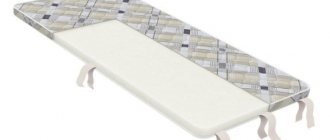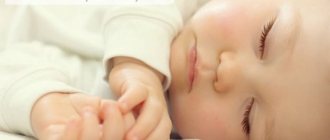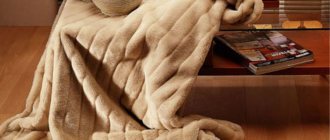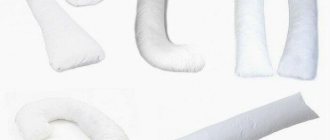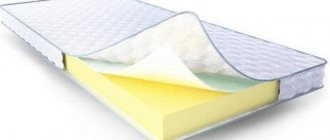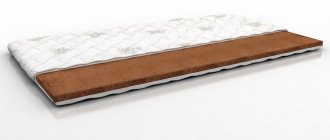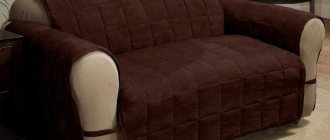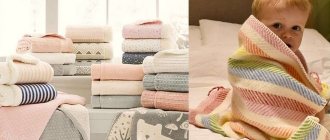In order for children to have sound and healthy sleep, you need to choose the right mattress. There are a huge number of models on sale, differing in filler, the presence of a spring block and even upholstery. Prices for various products start from 2,500 rubles. and higher. However, cost is not the only thing you should pay attention to. We share the best tips and useful life hacks to help you choose the perfect children's mattress.
- Mattress size
- Design
- Filler
- Upholstery
- Rigidity
- Versatility
- Orthopedic properties
- Age
- Manufacturer
- Price
| The best mattresses for children | ||
| 1 | Plitex Eco Lat | Universal product |
| 2 | Baby Sweet "Ryton" | Best orthopedic properties |
| 3 | EcoForm Cotton BabySleep | Maximum comfort |
| 4 | Baby Flex Dream "Ascona" | The optimum ratio of price and quality |
| 5 | Kids Smart "Ormatek" | The highest mattress |
Other ratings:
- 10 best tips for choosing a pillow for a child
Mattress size
Product width, length and height
The first thing you need to do to choose the right mattress is to take measurements from the crib: along the outer and inner perimeter. To avoid mistakes in the store, take a measuring tape with you, since all manufacturers label their products differently.
Length
should be 10-15 cm larger than the child’s height. For younger ages from 3 to 12 years old, standard mattresses are suitable, the length of which ranges from 160 to 190 cm.
Width
should be at least 2 times the width of the child’s shoulders. The width is usually from 60 to 120 cm.
Thickness
can vary from 15 to 24 cm. Keep in mind that the thickness of the mattress should allow the child to easily lie down and also easily get out of bed.
Special products are produced for newborns, the length of which is 95-120 cm and the width from 60 cm. Mattresses of these sizes provide reliable support for the baby’s spine. However, the sizes of cribs may vary, so when choosing, you need to base your choice on them.
Plitex Eco Lat
Universal product
The children's mattress from Plitex not only has orthopedic properties, but also different levels of rigidity. On the one hand, it is more rigid, therefore suitable for infants, on the other, it is less rigid and can be used up to 4 years. Rating participant:
10 best mattresses for newborns
How to choose the right mattress for a child?
When deciding how to choose a mattress for a child, you need to take into account a number of factors:
- the rigidity and characteristics of the filling material must correspond to the needs of the child’s age and weight;
- environmental friendliness and breathability of the coating material (upholstery);
- the dimensions of the mattress and crib must perfectly match each other;
- when buying a model for a child with allergies, you need to consult a doctor, and when purchasing, check the list of all components included in the composition and make sure that there is a certificate for the product;
- when a child has serious health problems, the choice requires consultation with a pediatric orthopedist.
When choosing a mattress for a child, you need to consider the above factors.
Which mattress should I choose for a child over 3 years old?
Unlike an infant, who needed a thin mattress with a hard surface, starting from 3 years old, a product with good anatomy (a surface that follows the contours of the body) is required. This means that we are talking about a moderate or medium degree of hardness:
- High-quality spring design (budget option);
- Either springless - monoblock or “puff” model
Design
With or without springs?
The key characteristic of each mattress is the presence or absence of a spring block. Looking ahead, it is worth noting that both types are suitable for a comfortable and complete rest.
On springs
. They are not recommended for children under 3 years old, so they are usually purchased for preschool children and teenagers. They are divided into two categories: with dependent and with independent spring block.
Models with dependent spring block
They are inexpensive, but have little orthopedic effect. All springs are fixed in a steel frame, which ensures the safety of the resting child and prevents him from accidentally falling during sleep.
Mattresses with independent block
Great for children who need spinal support (for example, with diseases of the musculoskeletal system). Among the disadvantages, it is worth highlighting the large weight of the products, which cribs are not always able to withstand.
Without springs
. The interior of such mattresses is made of one or 2-3 layers of filler. It can be natural or synthetic. We recommend choosing mattresses whose design consists of a combination of several materials. Springless products are an excellent solution for newborn babies and children aged 1-2 years.
Filler
Which filler is best for children?
The rigidity, elasticity and firmness of a children's mattress depend on the filler. For children, we recommend choosing natural materials that do not interfere with air circulation and can withstand even the highest loads.
Review of the best fillings for children's mattresses:
Coconut coir.
Natural hard material made from coconut fibers (coir) impregnated with natural latex. It has excellent orthopedic properties, therefore it is recommended for small children under 3 years old. When choosing, keep in mind that the thicker the coir, the harder the mattress will be.
Artificial or natural latex
. The main feature of the material is elasticity. Due to this, latex mattresses perfectly retain and restore their shape. They have good thermoregulation and are very durable. Their average service life is from 15 to 20 years. However, there is also a minus – the high price.
Viscoelastic (highly elastic) foam
. The properties are almost similar to latex, but there is a significant difference - thermoregulation is much lower. Otherwise, the material has no disadvantages. It remembers the contours of the human body, costs less than latex and distributes weight evenly.
Other fillers.
These include polyurethane foam, holofiber and horsehair. The first two materials are inexpensive and have excellent breathability, so they are suitable for children aged 5-6 years. Horsehair is very elastic and wear-resistant, but it is the most expensive and rare filler.
A great way to save money is to choose a combination mattress. In such products, the filler differs depending on the side. One might have coconut flakes, the other might have latex.
Which children's mattress is better to choose?
For a newborn, a springless mattress made of coconut coir, natural latex, polyurethane foam or a combination of several layers of these materials is suitable. For a child over 3 years old, you can buy both a spring and springless model. It cannot be said that one type of mattress has advantages over another. Choose a model based on the specific needs of the child. Whatever you choose, add a mattress protector to your cart as it will extend the life of any mattress.
| Age | Design | Rigidity | Mattress height |
| Up to 3 years | Springless | High | 6-10 cm |
| Preschoolers | Springless and spring | High, moderate and medium | 8-15 cm |
| Pupils | Springless and spring | High, moderate and medium | 11-25 cm |
Upholstery
What should the cover be like?
The upholstery determines how comfortable it will be to care for the mattress. There are mattress covers made from natural (cotton, linen) and artificial (polyester) materials to choose from. Another option is upholstery made of a combined fabric (for example, jacquard). All options are comfortable, but artificial materials impress with their water resistance.
Another nuance is the type of mattress cover. It can be removable or non-removable. For children, we recommend choosing removable models that are easy to wash.
EcoForm Cotton BabySleep
Maximum comfort
The BabySleep children's mattress is made with side aerators - air ventilation holes. This guarantees not only the durability of the product itself, but also maximum comfort while relaxing. Rating participant:
5 best premium mattresses
Rigidity
Which option should I choose for my child?
The main function of a children's mattress is to ensure the correct position of the spine and the child's comfort while sleeping. To do this, the product must have an optimal level of rigidity. There are three types of mattresses on the market.
Hard
. They do not sag or sag under load, so they are well suited for newborns and children under 3 years old. Natural materials (for example, coconut coir) are usually used as filler for hard mattresses.
Medium-hard
. Recommended for children from 3 to 7 years old. At this age, they begin the active growth phase and the musculoskeletal system is formed, so they need moderately hard mattresses that adapt to the rapidly growing children's body.
Soft
. For children over 7 years old, standard soft mattresses are suitable, since their musculoskeletal system is already formed. Here you only need to pay attention to the convenience, quality of the product and the filler used.
Which mattress is best for a child?
For an adult, healthy person, 8-9 hours a day is enough to sleep. For children this figure is higher. Recent research has led to the following daily guidelines for sleep:
- Preschoolers (3-5 years old) - 10-13 hours
- Primary and secondary school age (6-12 years) - 9-12 hours
- Teenagers - 8-10 hours
- High school students - 8-9 hours (“adult norm” of sleep)
An adult needs 8-9 hours of sleep per day; for children this figure is higher.
Considering how much time a child should spend sleeping, purchasing the “right” mattress is important. Sleeping on an uncomfortable surface interferes with proper muscle relaxation, disrupts blood circulation in the neck and causes the spine to take unnatural bends. All this, as a consequence, leads to developmental disorders of the musculoskeletal system.
Sleeping on an uncomfortable mattress, as a result, leads to developmental disorders of the musculoskeletal system.
Much has been written about firm mattresses for babies aged 0 to 3. The anatomical properties of the mattress are of no use to infants. The cartilaginous spine of newborns requires orthopedic support in the form of a rigid surface with a layer of soft covering.
The cartilaginous spine of newborns requires orthopedic support in the form of a rigid surface with a layer of soft covering.
The S-shaped curve of the spinal column completes its formation by the age of three. The cervical curve (up to 7 years) and the lumbar region (up to 12 years) continue to form. Actively developing internal organs, muscles and bones begin to add mass to the body. The hard surface now becomes uncomfortable. Very soft is also unacceptable. The medium-hard, low product is an excellent combination of anatomy and orthopedic effect.
The medium-hard, low product is an excellent combination of anatomy and orthopedic effect.
Anatomical - the ability of a mattress to take the shape of the body (as accurately as possible). Orthopedic effect - along with the presence of anatomy, the ability of the product to provide support to the spinal column (helping it stay straight).
Fortunately, today the risk of purchasing the “wrong” mattress in specialized outlets is low. Still, the question of how to choose a mattress for a child should be approached carefully, taking into account the following points:
- Filler material
- The degree of rigidity of the sleeping surface
- Mattress size
- Coating material
- Availability of a quality certificate
Check for a quality certificate.
Spring or springless options for a child?
Children's mattresses are divided into 2 categories:
Spring group.
It is based on a high-strength steel spring block.
- The classic Bonnel block is based on a system of dependent (attached to each other) springs.
- The improved Pocket Spring block is based on a system of independent springs, where each individual spring is enclosed in an individual case. Independent elements act pointwise, autonomously bending parts of the body.
In both versions (“Bonnel” and “Pocket Spring”), the spring block is covered with a layer (or several) of filler on top and bottom.
The spring block is covered with a layer (or several) of filler on top and bottom.
It cannot be said unequivocally that the spring group is unacceptable for children aged 3+. Modern, branded mattresses in this category are quite elastic and of good quality. However, some nuances can still be considered unacceptable or simply impractical. Eg:
- Models with a layer of filler (on top of the block) made of foam rubber and cotton wool are not recommended. They have insufficient rigidity and tend to accumulate and retain moisture. Cotton wool, among other things, tends to “roll” and lose its shape.
- Children aged 3-5 years are very mobile and active. During this period of life, the temptation to use a mattress as a trampoline is very great. Bonnell type models are perfect for jumping. But how long the product will withstand such a load without losing quality characteristics will directly depend on the quality of the spring block and the child’s temperament. Springless models are the undisputed leaders in this regard.
- The Bonnell type option, due to the dependent connection system of the elements, creates a wave effect when rotated. Low-quality models may well turn out to be a “hammock”, curving the spine and creating disturbing noise.
- The space inside the springs is a “double-edged sword”: on the one hand, it allows the product to “breathe”, on the other, it contributes to the accumulation of dust (over time).
- Before adolescence, a model with an independent block (“Pocket Spring”), in most cases, will not be able to fulfill its intended purpose - due to the low weight of the child. This means that it will be useless and will create the feeling of a hard, uncomfortable surface.
Some nuances of spring models can still be considered unacceptable or simply impractical.
There are no spring options in the 0-3 age range!
Springless models
Springless models can be monoblock or multilayer options. Mattresses with natural and artificial fillings are available for sale. Of the main ones:
- Latex (natural and synthetic)
- Coconut fiber (coir)
- PPU (polyurethane foam)
- Memory Effect Materials
- Holofiber
Mattresses with natural and artificial fillings are available for sale.
Less commonly: cotton wool, foam rubber, seaweed, buckwheat husks, sisal, flax fibers, abaca (Manila hemp) and others. The springless model is a win-win option. Some benefits:
- No dust collects in the interior space;
- There is no risk of feeling the “wave” effect when turning;
- There is no “hammock” effect;
- Wear resistance - not damaged by jumping;
- Latex models (natural) are the most durable and, in all respects, an ideal solution for children (this characteristic does not apply to those who are allergic to latex).
Latex models (natural) are the most durable and, in all respects, an ideal solution for children (this characteristic does not apply to those who are allergic to latex).
But there are several nuances:
- In some children, natural ingredients (coconut fiber, latex and others) can provoke allergic reactions;
- Conventional foam and cotton wool options are unacceptable.
Orthopedic mattresses for children
“Informed” modern parents are increasingly asking the question: does a child need a special orthopedic mattress? The question is dictated by care and concern for the well-being of a son or daughter. Therefore, there is a need to touch upon it.
Modern parents are increasingly asking themselves: does their child need an orthopedic mattress?
In a narrow sense, the term “orthopedic” refers exclusively to professional medical products. Currently, two factories have this certificate: Askona and Toris. If a child has real problems (impairments) in the formation or functioning of the musculoskeletal system, a professional orthopedic mattress may be recommended.
If a child has real problems in the formation or functioning of the musculoskeletal system, a professional orthopedic mattress may be recommended.
In all other cases, the term “orthopedic”, found in catalogs of finished products, is simply borrowed from the medical dictionary. But this is no reason to worry. Fortunately, the days of feather beds and cotton mattresses have sunk into oblivion. The modern industry strives to bring sleep products as close as possible to medical standards. Branded children's mattresses take into account all the characteristics of a developing child's body. Making a purchase at specialized points of sale, having a certificate and choosing from a category labeled “children’s” will ensure quality sleep and harmonious development.
Making a purchase at specialized points of sale, having a certificate and choosing from a category labeled “children’s” will ensure quality sleep and harmonious development.
What mattress firmness level is best for a child?
By the age of 3, the body begins to actively gain weight, the baby sleeps more on its side. If you do not switch from an infant mattress to a new model, there is a real threat of spinal curvature.
- On a surface that is too hard, your shoulders, hips, and lower back will be at the same level, and your spine will curve upward unnaturally.
- A surface that is too soft, on the contrary, will sag under the body weight (like a “hammock”) and the spine will inevitably begin to sag downward.
- Medium to moderate firmness is a great option. Heavier parts of the body (shoulders, hips) sink deeper, due to which the spinal column remains in a horizontal position.
So: starting from 3 years old, children’s mattresses are subject to criteria similar to those for adults. By and large, children's models of category 3+ differ from adults only in size, height and higher requirements for the quality of materials.
Heavier parts of the body (shoulders, hips) sink deeper, due to which the spinal column remains in a horizontal position.
Coconut mattresses for children
Coconut filler is latexed (impregnated with latex) or pressed coconut fiber. The rigidity of the product depends on the percentage of latex in the composition. Moisture-resistant, wear-resistant material. More in the hard category. A good option for overweight children (you need to consult a doctor).
It is better to consult a doctor before purchasing a mattress.
Unfortunately, there is a high risk of coming across a fake. Due to the high price of natural latex, dishonest manufacturers replace it with compounds containing toxic components. You can recognize their presence “by eye” by a suspicious smell and too low a price, but these are not the most reliable methods. Having a quality certificate and purchasing from trusted manufacturers is a more guaranteed option.
Hypoallergenic mattress for a child
Children with allergies are the most vulnerable category. It is important to understand what factors cause allergies. These are usually dust, dust mites, fungi and microorganisms. Materials prone to the accumulation of the listed allergens - foam rubber, cotton wool, batting, wool - are definitely unacceptable. Natural ingredients - horsehair, sisal, latex, coir, jute - also cause unwanted reactions in some children.
Polyurethane foam mattress.
A product whose fillers and coating materials do not cause allergic reactions in a particular child can be considered hypoallergenic. When purchasing a product, it is important to make sure:
- Quality certificate available;
- Make sure that the composition does not contain “dangerous” components;
- The fact is that the product has passed: antifungal, antimicrobial, anti-mite and anti-mold impregnations.
A mattress for a child with allergies should be chosen with a removable cover that can be washed frequently. A hypoallergenic mattress cover is reliable protection against dust and epidermis - particles that serve as food for bed mites that cause allergies. Regular care (ventilation, vacuuming, etc.) is an additional measure against allergies.
A hypoallergenic mattress cover is reliable protection against dust and epidermis - particles that serve as food for bed mites that cause allergies.
Versatility
Single-sided or double-sided mattresses?
Children's mattresses can be single-sided or double-sided. If everything is clear with the first ones, then the second ones differ in that they are suitable for sleeping on both sides. They are made from several materials at once, the number of which sometimes reaches 3-5 fillers at a time.
Double-sided mattresses are more expensive, but if you consider that the sides may differ in hardness, then such costs are well justified by comfort and durability.
Age
How to choose a mattress based on age?
We come to the most interesting part - choosing a mattress, depending on the age of the child. We tell you which products are suitable for whom:
Up to 3 years
. Choose hard mattresses, with natural fillers as a priority. The mattress cover must be removable; moreover, we recommend stocking up on several at once - the need to replace them may even arise several times a day.
From 3 to 7 years
. Your baby has grown up, and now the bed is a place not only for sleeping, but also for playing. Choose medium-hard mattresses with any filling. A removable mattress cover is optional, but it is still more convenient than a non-removable one.
From 7 years
. At this age, you can switch to regular soft mattresses. There are no longer any strict restrictions, so everything is left to the choice of the parents and the child himself. Just don’t forget to make sure that the brand’s products are certified before purchasing.
Baby Flex Dream "Ascona"
The optimum ratio of price and quality
Highly elastic foam, jacquard upholstery, height 11 mm - this is the best choice for newborns in the mid-price category. The cost of the mattress is 100% justified by its orthopedic properties and materials used in production. Rating participant:
10 best mattresses for newborns
Types of mattresses for children
The furniture market offers a wide variety of sleeping surfaces for children. They differ not only in cost and appearance, but also in orthopedic properties, hypoallergenicity, specific composition and filling. Depending on the age or individual characteristics of the baby, you have to settle on one option.
Foam rubber
When figuring out how to choose a mattress for a crib, you need to pay special attention to models made of foam rubber. Being an artificial material with good hypoallergenic properties, it is used not only for furniture production, but also for the medical industry. The key advantages of foam rubber products include a long service life if the rules of care are followed, good strength, and versatility. Depending on the degree of density, there are several types of filler:
- Standard;
- With increased rigidity;
- Soft and very soft;
- Special.
Rigid polyurethane foam
For newborn babies, the best mattress filling is hard polyurethane foam.
It has the required degree of elasticity and provides favorable conditions for a child’s safe sleep. Staying on such a surface, the baby is protected from numerous problems with the spine, and also gets a good rest. Models for babies are often equipped with waterproof mattress covers that protect the sleeping area from moisture. They also have good orthopedic properties, because... bend at the right points, ensuring that the correct proportions of the spine are maintained.
Latex
The ranking of the best children's mattresses also includes models made of natural latex.
This material is created on the basis of hevea juice or rubber, therefore it is hypoallergenic and absolutely safe. Other advantages of latex products include elasticity, resilience and strength. Also, such mattresses are moderately soft, protected from bacteria and dust, and durable. They are not afraid of exposure to moisture, and also quickly remove unpleasant odors.
Coconut fiber
Models of mattresses based on coconut coir are in particular demand.
If the correct production technology is maintained, they have virtually no disadvantages, with the exception of the high price. But you shouldn’t save on your baby’s health, because... affordable mattresses are often made from low-quality raw materials, which increase the risk of developing allergies and can release harmful substances during use. It is not difficult to distinguish natural fiber from cheap substitutes. Good material has a rich brown tint.
Combined mattresses
Combination mattresses may contain both natural and artificial fibers. But models from trusted manufacturers have the necessary characteristics and are ideal for use in a crib. They are protected from bacteria and dust mites, dry quickly, and also have good air exchange. The degree of elasticity is selected by the customer, which allows you to find the best options for children of different ages.
Spring children's mattresses
Sleeping surfaces with springs are made taking into account the anatomical structure of the child, so they have a good orthopedic effect.
They are recommended for preschool children and teenagers. Depending on the type of springs (independent or “bonnel”), the mattress can have a massage effect, protect the spine from deformation, and evenly distribute the load from the body over the surface.
When choosing a children's mattress, you need to be guided by both personal experience and expert advice. It is important to remember that the comfort of a baby’s sleep and rest directly depends on the quality of the surface on which it is placed.
Manufacturer
Brands you can trust
Choose mattresses for children only from reliable Russian or foreign manufacturers. If you decide to save money and buy a product from a little-known brand, then be sure to request a Certificate of Quality! Companies you can trust are popular brands whose products are well-known.
Askona –
is a Russian manufacturer whose collections include spring and springless mattresses.
Mediflex –
a domestic company specializing in the production of orthopedic products with various fillers.
Dormeo
is an Italian brand that offers a huge selection of mattresses made from natural materials for children.
IKEA
is a Swedish company that produces products of consistently high quality at very attractive prices.
Other brands offering comfortable, safe and high-quality mattresses include: DreamLine, Peligrin, Lance Elin, Violite, Sakura, Ormatek.
Choosing the firmness of a mattress for a child from three to seven years old
Mattresses for children from three to seven years old do not have a specific hardness. The choice depends on the age of the child. The younger he is, the harder the sleeping place should be, but not as hard as for newborns. You cannot take a standard approach to choosing a mattress for a child with musculoskeletal problems. The latter need a hard surface to sleep on.
Ideally, the firmness of a mattress ranges from moderate to medium. The latter is chosen for children of primary school age. They feel as comfortable as possible on such a surface: they completely relax and get a good night’s sleep.
Top 5. Kids Smart "Ormatek"
Rating (2021): 4.40
For children from 3 to 12 years old, a mattress from Ormatek based on the innovative 4D Smart block (512 springs per bed) is well suited. Natural coconut coir is used as a filler, but keep in mind that this makes the mattress quite expensive compared to other products. One of the features of the model is different covers. For mattresses with a width of up to 70 cm and a length of up to 140 cm, the cover is removable, for products of larger sizes it is non-removable. The height is 17 cm, the maximum weight per bed reaches 100 kg. The warranty on the mattress is 2.5 years or 5 years. To get an extended warranty, you will have to purchase an additional mattress cover, and if you take into account that the cost of the product itself is already quite high, then the costs increase.
Characteristics:
RUB 14,770 / Russia / Type: with independent spring block
Top 4. Baby Flex Dream "Ascona"
Rating (2021): 4.50
An orthopedic springless mattress from Askona is an excellent choice for newborn babies. It is based on a block of highly elastic polyurethane foam, the main advantage of which is hypoallergenicity. On both sides the polyurethane foam is covered with linen, which prevents compression of the baby's soft tissues. This is a natural and safe material that creates a healthy microclimate. As for the cover, it is removable and made of jacquard. A big plus is the additional antibacterial impregnation. The height of the mattress is 11 cm; on sale you can find products with different lengths and widths.
Characteristics:
RUB 4,622 / Russia / Type: springless
Recommendations from experts
Experts warn parents against the temptation to buy a mattress to grow into. It is highly undesirable to put your baby in a teenage bed in order to save money. The baby feels uncomfortable in a large space, which negatively affects the quality of his sleep.
To create the necessary conditions for your child, select a mattress according to the size, required hardness and from a reliable manufacturer.
How to choose the right mattress for a child and what to look for when choosing in the video:
Top 3. EcoForm Cotton BabySleep
Rating (2021): 4.60
The main feature of this mattress is the Naturalform block, which is a new generation hypoallergenic material. It is quite elastic and provides good breathability. Pure coconut slabs are also used as filler. They make the mattress more rigid and hygienic. Additionally, the model has ventilation holes - aerators, which ensure a comfortable sleep for the child. The removable cover is made of high-quality jacquard with antistatic impregnation. Mattress height – 11 cm.
Characteristics:
RUB 4,889 / Italy / Type: springless
Top 2. Baby Sweet "Ryton"
Rating (2021): 4.90
If you are looking for a mattress for a child aged 1 to 6 years, then pay attention to the Rayton model. It is made on the basis of a combined foam filler, which provides support for the children's spine and excellent orthopedic properties. The foam adapts to the curves of the body, but does not press through over time. The set includes a jacquard cover, but there is a minus here for the buyer - it is not removable. The product warranty is 1.5 years. Height – 11 cm. The manufacturer claims that the service life of the mattress reaches 10 years. Considering that it is relatively inexpensive, this is quite enough.
Characteristics:
RUB 4,550 / Russia / Type: springless

